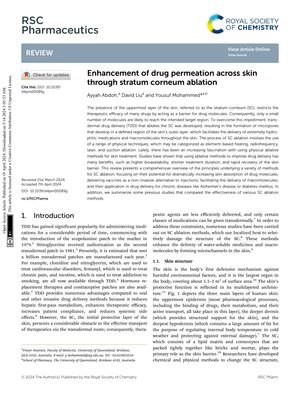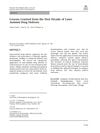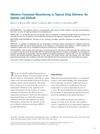Enhancement of Drug Permeation Across Skin Through Stratum Corneum Ablation
January 2024
in “
RSC pharmaceutics
”
stratum corneum ablation transdermal drug delivery PassPort™ system micropores radiofrequency microporation RF microporation fluorescein isothiocyanate-dextrans FITC-dextrans RF combined with microneedles RFMN male pattern hair loss ablative fractional lasers AFLs P.L.E.A.S.E.Ⓡ laser suction ablation AFL-Er:YAG hypertrophic scars xanthelasma palpebrarum lesions AFL-CO2 acne scars SC ablation TDD PassPort RF microneedles hair loss fractional lasers P.L.E.A.S.E. laser Er:YAG laser CO2 laser

TLDR Removing the outer skin layer increases drug absorption and offers non-invasive treatment options, with some methods allowing for quick skin recovery.
The document reviews methods for enhancing transdermal drug delivery (TDD) by ablating the stratum corneum (SC). It highlights the PassPort™ system's effectiveness in creating micropores for drug delivery, with studies showing increased skin permeability and rapid recovery. Other methods discussed include radiofrequency (RF) microporation, which increased permeability for fluorescein isothiocyanate-dextrans (FITC-dextrans), and RF combined with microneedles (RFMN), which improved hair count and thickness in male pattern hair loss treatment. Ablative fractional lasers (AFLs) and the P.L.E.A.S.E.Ⓡ laser were also mentioned for their ability to create microchannels with minimal skin damage. Suction ablation, while effective, is considered invasive with risks of infection and scarring. AFL-Er:YAG was most effective in treating hypertrophic scars and xanthelasma palpebrarum lesions, while AFL-CO2 was better for acne scars. The document concludes that SC ablation methods significantly enhance drug absorption, offering a non-invasive alternative for various treatments, with technologies like PassPort™, RF microporation, and fractional lasers improving bioavailability and allowing for quick SC recovery. Suction ablation is less favored due to its invasiveness. Understanding the skin permeation characteristics of these devices is crucial for their application in delivering specific medications.



